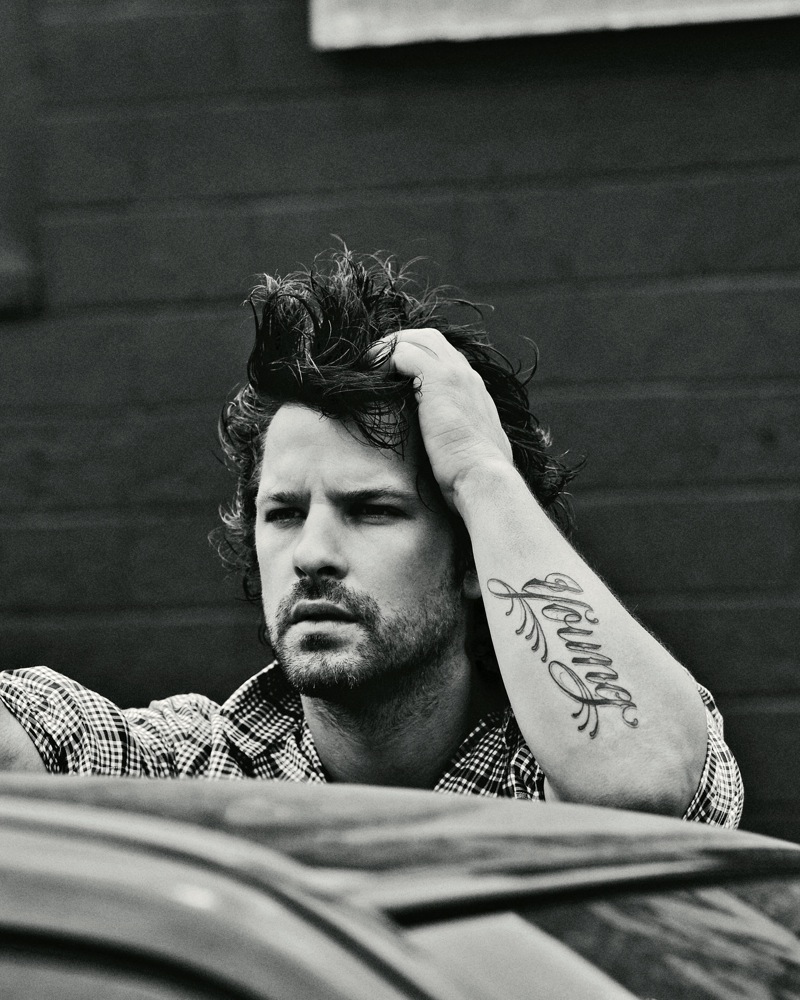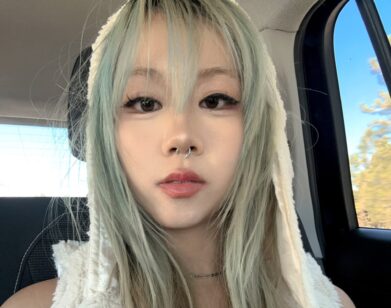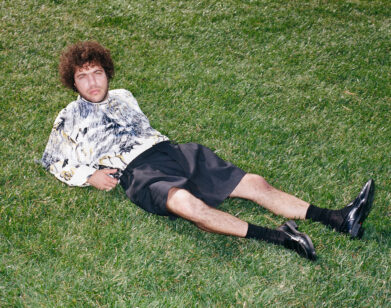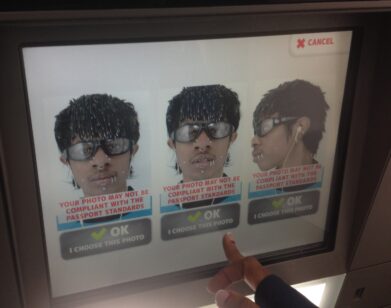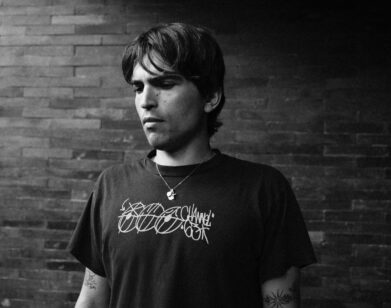Aaron Young
Beware: Aaron Young leaves a mark. The artist, in fact, made lots of marks when he unleashed a crew of motorcyclists to pop burnouts on a floor of painted boards last year at New York’s Park Avenue Armory. He also sprays surfer tags on his enameled-bronze rocks, creates sculptures that look like broken-down chain-link fences (dipped in gold), and even burns the impression of Jesus Christ onto corneas after a viewer stares at one of his psychedelic silk-screen paintings for 30 seconds. Young is a Californian by birth and also by artistic practice—he’s like a hippie who wised up to hard reality and is now part tough guy, part total sweetheart. His work deals in that ongoing scrimmage between countercultural expression and commercial artifact. As the downtown art star prepares for another motorcycle performance in Moscow and a solo show at New York City’s Bortolami Gallery in November, he talks with his friend and fellow artist Adam McEwen about trips, trades, and trade-offs in Young’s new apartment.
ADAM McEWEN: I like your new loft. It’s great. What are those on the table?
AARON YOUNG: Kinoki?
AM: On the table are Kinoki Detox Foot Pads. Where did you get those?
AY: I had to go to Duane Reade the other day to get passport pictures for a visa for Moscow. It’s summertime so I felt like detoxicating myself.
AM: Are you photographing your feet?
AY: I haven’t taken any documentation of the progress of Kinoki Detox Foot Pads.
AM: It’s body-cleanse through the foot. Why are you going to Moscow?
AY: To make a performance similar to the one that I did last September with motorcycle riders. This time we’re using all motorcycle riders from Moscow to have more of a social-sculpture aspect. In New York we used all motorcycle riders from here. I’m actually going in a week to do recruiting. I was supposed to go with my main motorcycle rider, Wink 1100 from the Bronx, but he’s having problems with his passport. So a little American white boy has to go over there and talk to all of these tough Russian burnout specialists.
AM: Is there a burnout scene in Moscow?
AY: It’s huge, actually. When I was there the last time, some guy tried out for me in the garden restaurant while we were having dinner. He just showed up.
AM: What colors will the panels on the ground be?
AY: The performance is taking place at an old chocolate factory right on the Moscow River, and it’s across from the Kremlin.
AM: So will you make red panels?
AY: I thought that would be too easy. There’s a gold dome on this church right across the river. So I’m going to do four shades of gold with black on the top. I have 24-karat gold sculptures going into the rest of the show. It’s a Gagosian group show.
AM: Are they for sale?
AY: No. I think they’re just going to be proofs.
AM: You should sell them.
AY: I’ll have to look at the exchange rate that day. I don’t know the price of gold. Is the price of gold the same everywhere? Is it the same in Russia as it is in the U.S.?
AM: I’m not sure. Where do you buy your gold?
AY: That’s what I’m wondering. Then I can set my prices for my sculptures based on that. [laughs]
I grew up surfing in California. It has heavily influenced my sculpture. Surfing is a very territorial thing.Aaron Young
AM: It’s funny, when you think of motorcycles and art, you think of Michael Heizer in the early ’70s in the desert. But it’s an interesting evolution from the early ’70s to Tom Ford, who sponsored your piece at the Armory.
AY: The Armory became this snowballing monster . . . These days, especially to do a big performance in New York, it costs a lot of money to produce. Tom and Sotheby’s were amazing to throw down the cash. But it’s hard not to drain the idea while getting caught up with who gave the money. Everybody starts to pick apart all of that stuff that went in to producing it, rather than the idea itself. There are choices and compromises. Art Production Fund was rad. I had final decision on everything. Whether I made the right decisions or not, that’s already past. Moscow will be different.
AM: The Moscow bikers will make a different piece, presumably, than the New York bikers.
AY: When I go and I meet the guys, I just shut my mouth and let them show me what they can do. It’s just like using material, or drawing a line . . . You use their craft, and you formulate it into the idea that you have. It’s just like using wood or metal or whatever.
AM: Meanwhile, you’re going surfing?
AY: Yeah, I go to Costa Rica at 6 A.M. tomorrow.
AM: Did you learn to surf in California?
AY: I grew up surfing in California, since I was 10 years old. It has heavily influenced my sculpture. Surfing is a very territorial thing.
AM: I was thinking about your silk-screens for sexual-power pills and buff bodies. That’s like a weird inversion of California health. People think of California as natural, and then you copy those over-the-counter 75-cent pill packets.
AY: They’re the sight-buys-all the stuff that they have at the checkout in delis. I’m sure that the salesmen for these things come up to the clerks, and they’re like, “Let’s position this by the cash register so we can have sex and money right next to each other.” It’s like, “I’m going to take this six-pack of beer, this granola, and the Top Gun sexual stimulant.”
AM: I always do. It goes from a hippie with a daisy in her hair to the fake energy supplement at the deli counter. In the end, there’s always a product. The ginseng supplement at the deli counter is a product for sale, and even artwork that riffs on it is a product for sale.
AY: With anything that you produce as an artist, you have a choice of putting it out or not. What makes up your practice? Is it stuff that you hold onto, the stuff that you put for sale, or what you show? There’s a lot more to all of us as artists than what people see in the galleries. There’s tons of other stuff that we’re doing on a daily basis. You’re only seeing so much of it.
AM: It would be good to be riding motorbikes on a daily basis instead, like those guys.
AY: I’m actually scared of motorbikes. I thought about buying one once, but I got a car instead. That didn’t work out well.
AM: I was once in a car with you at the wheel in Miami. It was very scary.
AY: I was going down one-way streets the wrong way. Dash [Snow] was in the front seat.
AM: That was an alarming moment. Have you seen the new Batman, the Christian Bale film?
AY: It’s actually the Heath Ledger film. In one of the films Ledger made, Lords of Dogtown [2005], they have great graffiti from early Venice Beach, like, “If you don’t live here, don’t surf here.” There’s a “Go home,” there’s a “Locals only.” On a few of my rock sculptures, I write “Go home,” “Locals only,” stuff like that-on the bronze pieces.
AM: Did you take those from that film?
AY: No. I used to write that when I was a kid in Carmel, in Monterey, in Big Sur. Our places started to become well known. Like I said, surfing’s very territorial. When you’re in the water, there are only enough waves for a certain amount of people.
AM: What does “locals” mean? How local?
AY: You could become a local whether you lived an hour away or not, just as long as you surfed there at least three or four times a week. But you’d have to get your way into that “lineup,” is what they call it, when you’re out in the water.
AM: You’d be accepted if you were good and regular.
AY: You would get good, that’s the thing. If you just showed heart, really, if you just kept on coming back . . .
AM: Were you accepted?
AY: I’ve gotten hit in the face, when I’ve been out there on my board. I’ve almost died many times, not from other people but from waves. I’m not saying that to sound cool.
AM: “Hero artist survives brutal beating.”
AY: That’s why we’ve become good friends—
AM: I’ve never met you before.
AY: We have the same foundation. We both went to art school in California, even though you’re from Scotland. That’s why we understand each other.
AM: It’s funny how many of those West Coast conceptual artists were really just stoners tripping out, getting into nerve endings. Didn’t Robert Smithson smoke a lot of dope? Was there a lot of Ecstasy in San Francisco? There’s a lot of it in London.
AY: Are you kidding? I used to throw parties for about three years. That pretty much—that and other things—paid for my undergrad. And also confiscating drugs from all of the little kids and reselling them at the same parties! We had a shakedown system.
AM: That’s a pretty slick system.
AY: It was funny when the little kid that walked in with 50 hits of Ecstasy got his stuff sold back.
AM: Poor kid. That’s like art history. Steal it, reuse it, resell it. Next.
AY: Take control of all the materials that you have, set the boundaries, set the parameters, and make whatever you can out of it.
AM: Do you think a lot of art gets recycled?
AY: You’re talking about a word like reference, right? Some people use it as this crutch that forms the armature of their piece, as in, “This is a validated artwork that I am referencing. This makes it legit artwork because it’s referencing this brush stroke or these colors.” You need to make up your own armature. Although I do think you need to nod at the past and wink at the future with everything that you do.
AM: Do you think artists make better work when they’re wearing designer clothes?
AY: I don’t think I’ve ever made art in designer clothes.
AM: Basquiat made some great art wearing designer clothes. It’s a very Warholian thing. It’s like, say yes to everything. Didn’t Balenciaga send you a bunch of shit in a cardboard box a couple of months ago?
AY: Yes.
AM: I saw Gardar [Eide Einarsson] wearing a pair of leather drawstring pants. Shiny leather soft trousers.
AY: They were very dark green leather trousers. But they were like sweats, like warm-up pants. They had elastic that bubbled at the bottom.
AM: Did you ever wear those?
AY: I sent them—
AM: You’re wearing them now. You’re lying.
AY: I sent everything back. I did not take anything.
AM: You’re wearing all of it right now.
AY: I did not take anything from it. But Adam Kimmel just made me like six or seven suits—three-piece suits, which are sick.
AM: What does he get from that?
AY: We have an agreement. I gave him one painting, and now I have clothes for life.
AM: It’s good to trade.
AY: Yeah. I would rather trade an artwork than sell an artwork. How about you?
AM: I like trading.
AY: That’s not a fuckin’ answer. It’s one or the other. Do you like to trade or do you like to sell? Would you rather have money or would you rather have art?
AM: I can’t pay my rent trading. But I wouldn’t say I prefer to trade than sell . . . There are not that many things I want. I know people who trade dentistry for art.
AY: I do that. I had to! I had two root canals. Artists don’t usually have insurance.
AM: I would love to trade art for dentistry, actually. But I also want my art to go to people who really want it.
AY: Well, what if the dentist is a collector? How would you feel if your painting was hanging in the dentist’s office?
AM: I think that would be fine.
AY: I have a gigantic painting hanging in my dentist’s office. But he bought that one.

